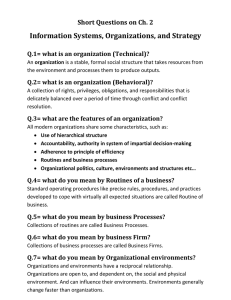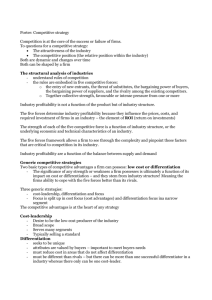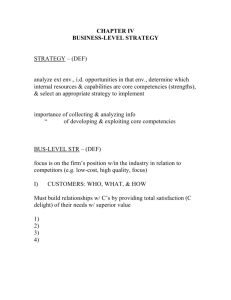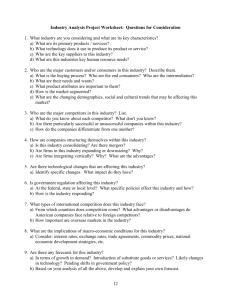Lecture # 23
advertisement
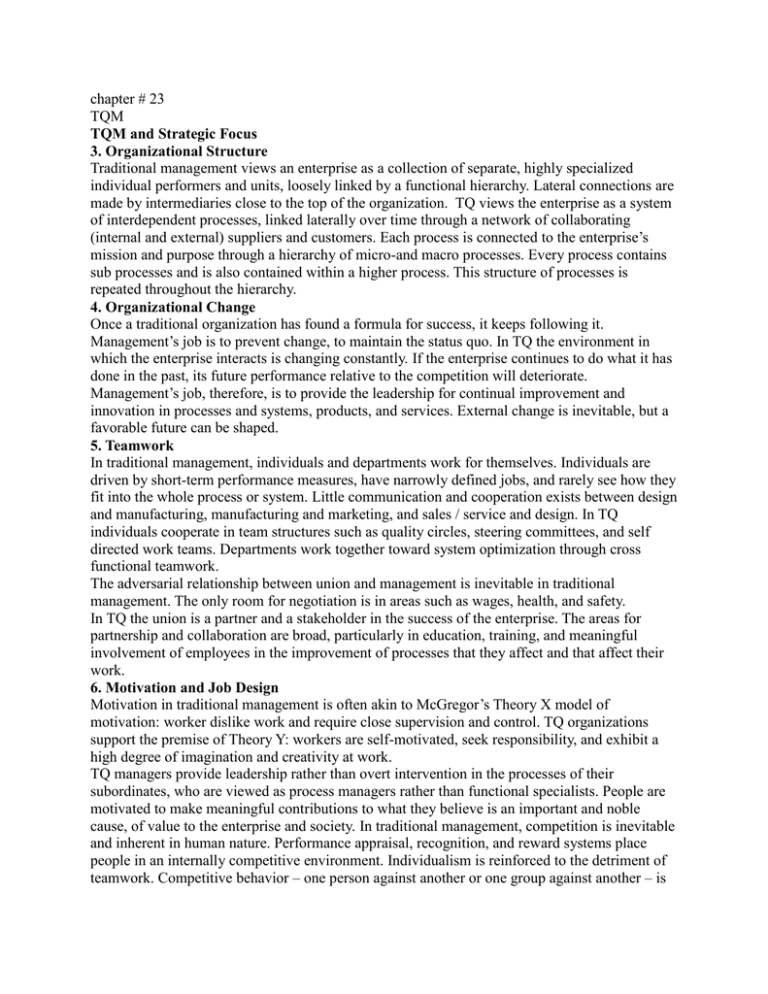
chapter # 23 TQM TQM and Strategic Focus 3. Organizational Structure Traditional management views an enterprise as a collection of separate, highly specialized individual performers and units, loosely linked by a functional hierarchy. Lateral connections are made by intermediaries close to the top of the organization. TQ views the enterprise as a system of interdependent processes, linked laterally over time through a network of collaborating (internal and external) suppliers and customers. Each process is connected to the enterprise’s mission and purpose through a hierarchy of micro-and macro processes. Every process contains sub processes and is also contained within a higher process. This structure of processes is repeated throughout the hierarchy. 4. Organizational Change Once a traditional organization has found a formula for success, it keeps following it. Management’s job is to prevent change, to maintain the status quo. In TQ the environment in which the enterprise interacts is changing constantly. If the enterprise continues to do what it has done in the past, its future performance relative to the competition will deteriorate. Management’s job, therefore, is to provide the leadership for continual improvement and innovation in processes and systems, products, and services. External change is inevitable, but a favorable future can be shaped. 5. Teamwork In traditional management, individuals and departments work for themselves. Individuals are driven by short-term performance measures, have narrowly defined jobs, and rarely see how they fit into the whole process or system. Little communication and cooperation exists between design and manufacturing, manufacturing and marketing, and sales / service and design. In TQ individuals cooperate in team structures such as quality circles, steering committees, and self directed work teams. Departments work together toward system optimization through cross functional teamwork. The adversarial relationship between union and management is inevitable in traditional management. The only room for negotiation is in areas such as wages, health, and safety. In TQ the union is a partner and a stakeholder in the success of the enterprise. The areas for partnership and collaboration are broad, particularly in education, training, and meaningful involvement of employees in the improvement of processes that they affect and that affect their work. 6. Motivation and Job Design Motivation in traditional management is often akin to McGregor’s Theory X model of motivation: worker dislike work and require close supervision and control. TQ organizations support the premise of Theory Y: workers are self-motivated, seek responsibility, and exhibit a high degree of imagination and creativity at work. TQ managers provide leadership rather than overt intervention in the processes of their subordinates, who are viewed as process managers rather than functional specialists. People are motivated to make meaningful contributions to what they believe is an important and noble cause, of value to the enterprise and society. In traditional management, competition is inevitable and inherent in human nature. Performance appraisal, recognition, and reward systems place people in an internally competitive environment. Individualism is reinforced to the detriment of teamwork. Competitive behavior – one person against another or one group against another – is not a natural state in TQ. TQ reward systems recognize individual as well as team contributions and reinforce cooperation. 7. Management and Leadership Traditional management views people as interchangeable commodities, developed to meet the perceived needs of the enterprise. People are passive contributors with little autonomy-doing what they are told and nothing more. TQ views people as the enterprise’s true competitive edge. Leadership provides people with opportunities for personal growth and development. People are able to take pride and joy in learning and accomplishment, and the ability of the enterprise to succeed is enhanced. People are active contributors, valued for their creativity and intelligence. Every person is a process manager presiding over the transformation of inputs to outputs of greater value to the enterprise and to the ultimate customer. Competitive Advantage on basis of Quality Strategy A firm has many options in defining its long-terms goals and objectives, the customers it wants to serve, the products and services it produces and delivers, and the design of the production and service system to meet these objectives. Strategic planning is the process by which the members of an organization envision its future and develop the necessary procedures and operations to carry out that vision. Competitive Advantage on basis of Quality Strategy Strategy – the result of strategic planning – is the patter of decisions that determines and reveals a company’s goals, polices, and plans to meet the needs of its stakeholders. An effective strategy allows a business to create a sustainable competitive advantage. Quality as a Strategy The concept of strategy has different meanings to different people. James Brian Quinn characterizes strategy as follows: A strategy is a pattern or plan that integrates an organization’s major goals, policies, and action sequences into a cohesive whole. A well formulated strategy helps to marshal and allocate an organization’s resources into a unique and viable posture based on its relative internal competencies and shortcomings, anticipated changes in the environment, and contingent moves by intelligent opponents. Quality as a Strategy Formal strategies contain three elements: 1. Goals to be achieved, 2. Policies that guide or limit action, and 3. Action sequences, or programs, that accomplish the goals. Effective strategies develop around a few key concepts and thrusts that provide focus. The essence of strategy is to build a posture that is so strong in selective ways that the organization can achieve its goals despite unforeseeable external forces that may arise. The traditional focus of business strategies has been finance and marketing. These parallel two of the principal sources of competitive advantage i.e. cost and differentiation. Total quality – with a focus on people – leads t improvements in both areas. Therefore, quality can be viewed as a strategy in itself. The role of quality in business strategy has taken two significant steps since 1980. First, many firms have recognized that a strategy driven by quality can lead to significant market advantages. Second, the lines between quality strategy and generic business strategies have become blurred to the point where TQ principles are integrated into most businesses’ normal business planning; that is, TQ is a basic operating philosophy that provides the foundation for effective management.For most companies, integration of TQ into strategic business planning is the result of a natural evolution. For most new companies – or those that have enjoyed a reasonable measure of success – quality takes a back seat to increasing sales, expanding capacity, or boosting production. Strategic planning usually focuses on financial and marketing strategies. As a company begins to face increasing competition and rising consumer expectations, cost-cutting objectives take precedence. Some departments or individuals may champion quality improvement efforts, but quality is not integrated in the company’s strategic business plan. In the face of market crises, which many U.S. firms experienced in the 1970s and 1980s, top management begins to realize the importance of quality as a strategic operating policy. In many cases, however, quality is considered separate from financial and marketing plans. Companies that aspire to world-class status reach the highest level of evolution where quality becomes an integral part of the overall strategic plan and is viewed as a central operating strategy. Competitive advantage denotes a firm’s ability to achieve market superiority over its competitors. In the long run, a sustainable competitive advantage provides above-average performance. A strong competitive advantage has six characteristics: 1. It is driven by customer wants and needs. A company provides value to its customers that competitors do not. 2. It makes a significant contribution to the success of the business. 3. It matches the organization’s unique resources with the opportunities in the environment. No two companies have the same resources; a good strategy uses them effectively. 4. It is durable and lasting and difficult for competitors to copy. A superior research and development department, for example, can consistently develop new products or processes to remain ahead of competitors. 5. It provides a basis for further improvement. 6. It provides direction and motivation to the entire organization. As each of these characteristics relates to quality, quality can be an important means of gaining competitive advantage. Let us see how total quality contributes to competitive advantage. • Discuss cost leadership, differentiation, and people as principal sources of competitive advantage, and their relationship to quality; • Relate quality to the achievement of higher profitability; • Describe the importance of quality in meeting customer expectations in product design, service, flexibility and variety, innovation, and rapid response; and Sources of Competitive Advantage The classic literature on competitive strategy suggests that a firm can posses’ two basic types of competitive advantage: low cost and differentiation. Cost Leadership Many firms gain competitive advantage by establishing themselves as the low-cost leader in an industry. These firms produce high volumes of mature products and achieve their competitive advantage through low prices. Such firms often enter markets that were established by other firms. They emphasize achieving economies of scale and finding cost advantages from all sources. Low cost can result from high productivity and high capacity utilization. More importantly, improvements in quality lead to improvements in productivity, which in turn lead to lower costs. Thus a strategy of continuous improvement is essential to achieve a low-cost competitive advantage. Cost Leadership To achieve cost leadership for high volume products, companies use a variety of approaches: • Early manufacturing involvement in the design of the product both for make-versus-buy decisions and for assurance that the production processes can achieve required tolerances. • Product design to take advantage of automated equipment by minimizing the number of parts, eliminating fasteners, making parts symmetric whenever possible, avoiding rigid and stiff parts and using one-sided assembly designs. • Limited product models and customization in distribution centers rather than in the factory. Cost Leadership • A manufacturing system designed for a fixed sequence of operations. Every effort is made to ensure zero defects at the time of shipment. Work-in-process inventory is reduced as much as possible, and multi skilled, focused teams of employees are used. A cost leader can achieve above-average performance if it can command prices at or near the industry average. However, it cannot do so with an inferior product. The product must be perceived as comparable with competitors or the firm will be forced to discount prices well below competitors’ prices to gain sales. This can cancel any benefits that result from cost advantage. Differentiation To achieve differentiation, a firm must be unique in its industry along some dimensions that are widely valued by customers. It selects one or more attributes that customers perceive as important and positions it uniquely to meet those needs. For instance, Dell’s direct business model was the first of its kind in the computer industry and continues to be a principal source of the company’s success. Often, a firm with a differentiation strategy can command premium prices and achieve higher profits. Juran cites an example of a power tool manufacturer that improved reliability well beyond that of competitors. Field data showing that the differences in reliability resulted in significantly lower operating cost were publicized, and the company was able to secure a premium price. However, a firm that uses differentiation as its source of competitive advantage must make its products or systems difficult to copy. Often this involves culture, habits, and sunk costs. For example, why doesn’t every company copy Dell’s superior direct business model? Dell’s approaches are hardly a secret; even Michael Dell has written a book about it. Competitors have copied its Web site with stunning precision, but they face far greater difficulty copying the supporting activities–purchasing, scheduling, and logistics–that Dell has built around its direct model over several decades. Competitors are burdened by long-standing relationships with suppliers and distributors and by a different culture. People The competitive advantage resulting from an organization’s people can drive low cost and differentiation. For example, over several decades, Southwest Airlines has been the most profitable U.S. carrier. It has fewer employees per aircraft and flies more passengers per employee. Much of its cost advantage comes from its very productive, motivated, and unionized workforce. Is its competitive advantage low cost, or is it the people? It would appear that the real driver of Southwest’s competitive advantage is its people. Herb Kelleher, former CEO, once stated, “It’s the intangibles that are the hardest things for competitors to imitate.
